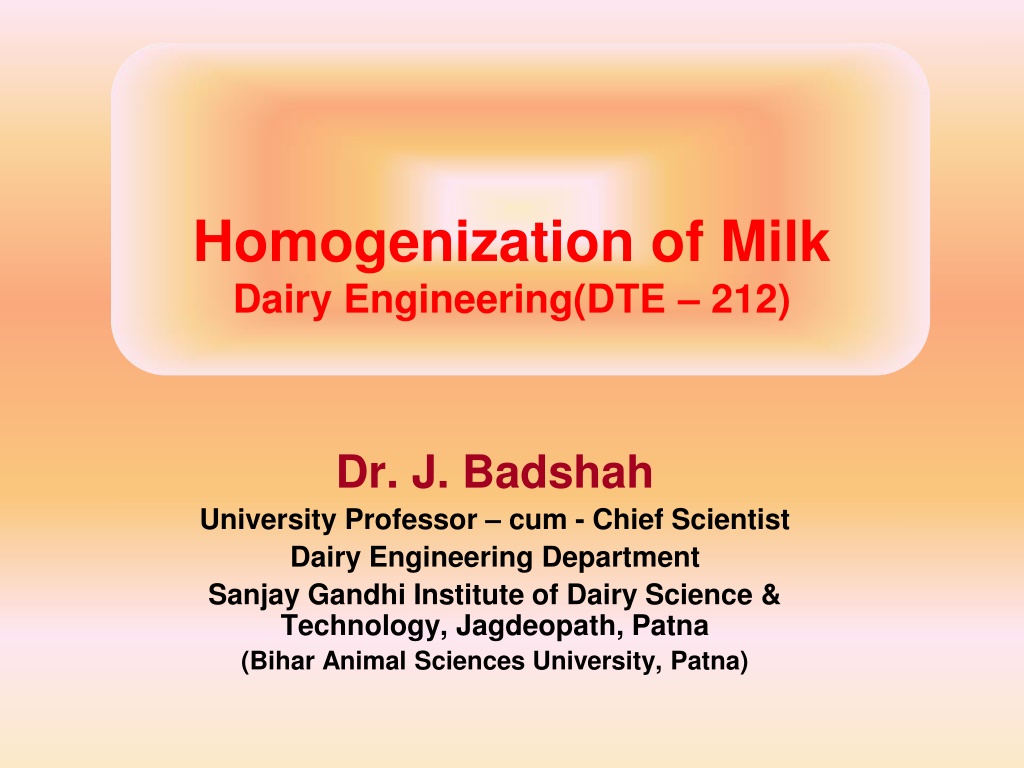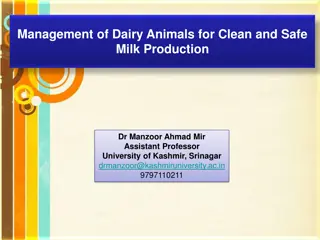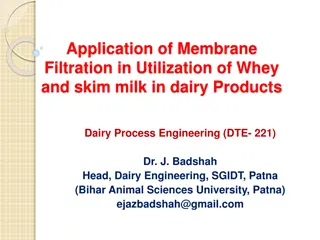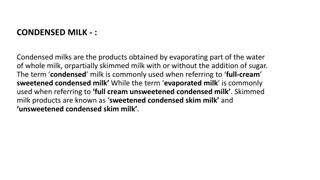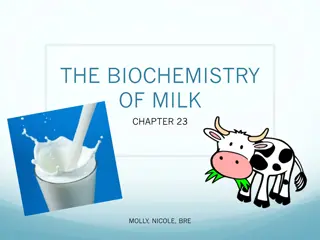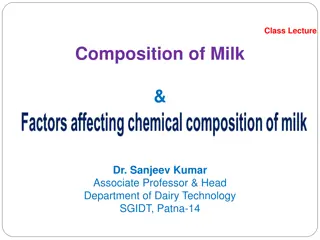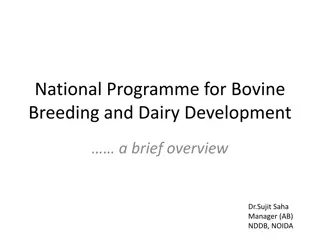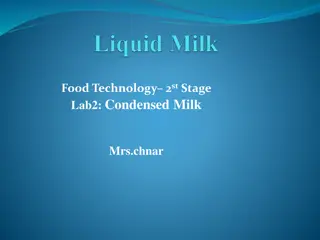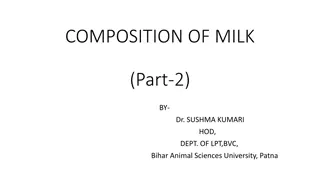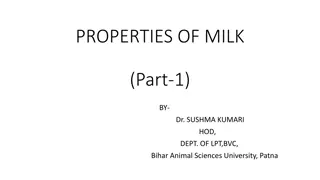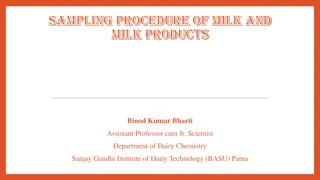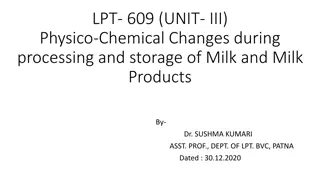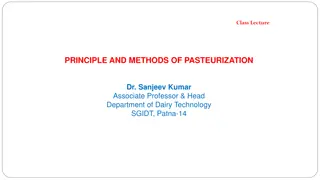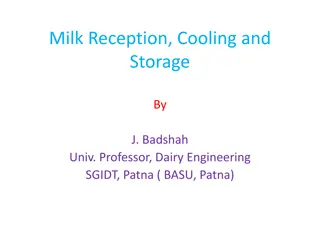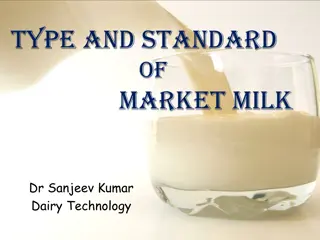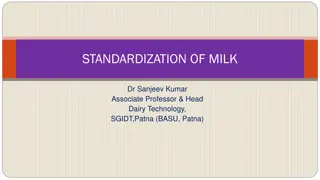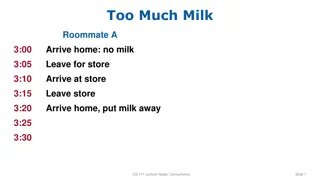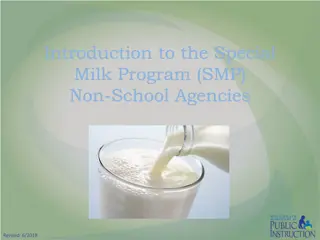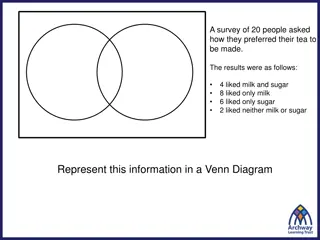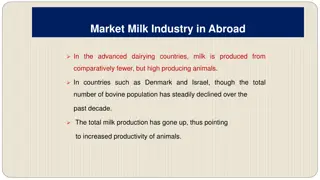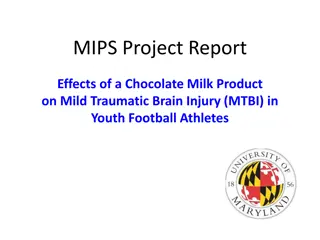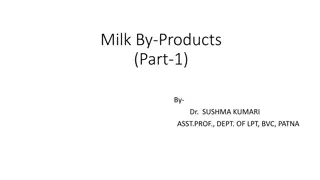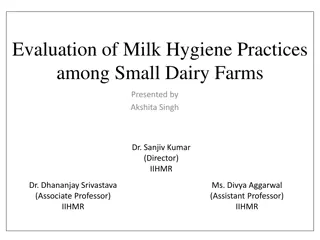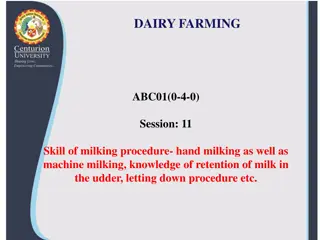The Science of Milk Homogenization in Dairy Engineering
Explore the principles and effects of homogenization on milk properties, including changes in fat globule size, viscosity, and enzyme activation. Discover the theory behind homogenization involving shearing, cavitation, and micro turbulence. Learn about the process of homogenization through high-velocity pumping of milk at elevated temperatures.
Download Presentation

Please find below an Image/Link to download the presentation.
The content on the website is provided AS IS for your information and personal use only. It may not be sold, licensed, or shared on other websites without obtaining consent from the author. Download presentation by click this link. If you encounter any issues during the download, it is possible that the publisher has removed the file from their server.
E N D
Presentation Transcript
Homogenization of Milk Dairy Engineering(DTE 212) Dr. J. Badshah University Professor cum - Chief Scientist Dairy Engineering Department Sanjay Gandhi Institute of Dairy Science & Technology, Jagdeopath, Patna (Bihar Animal Sciences University, Patna)
Different between Process Control & Product Control S.No. 1. Unhomogenized Milk Milk Fat in the form of globules from 0.1 to 20 mm. Homogenized Milk Fat globule size is reduced to 1 micron or less. 2. Wide globules and wide variation in size. variation in density of fat No variation in density and size of fat globules 3. Formation of cream layer when the milk is left undisturbed causing non uniform distribution in the sense of quality of milk. Surface area of fat globules are about five times lesser in unhomogenized milk Prevents creaming in stored milk and packed milk causing uniform quality distribution consumer. Homogenization principle of surface area providing flavour to milk but at the cost of expense of energy. . It brings physical changes in milk proteins resulting in lower curd tension that digestibility of homogenized milk to the 4. uses the the increasing richer 5. Curd tension is higher and digestibility of unhomogenized milk and products made from it is lower. increases
Effects of Homogenization on properties of milk UV Light Susceptibility Effect on viscosity due to shearing and cavitation action in first stage homogenization Effect on viscosity in second stage homogenization Effect of activation of inherent lipase system due to homogenization- hydrlytic rancidiy Necessity of pasteurization of milk after homogenization to inactivate the lipase enzyme Why homogenization of milk at a temperature of 57 C a) Higher efficiency b) Activity of lipase on newly formed fat globule surfaces Homogenization Index= (A- B) /B x 100 Homogenization Index between 1 to 10: Good
Theory of Homogenization Shearing of milk layers a. High shear gradients/ velocity gradients b. Accelerating and retarding shearing action c. Thread like shapes to form small globules with small forces d. Disintegration of fat globules Cavitation in flow of milk a. Kinetic energy increases and potential energy decreases b. Static pressure becomes as low as vapour pressure of liquid which forms the vapour bubbles c. Implosion of vapour bubbles with breaker ring causes deformation and disintegration of globules Micro turbulence a) High velocity of 100 - 250 m/s through narrow slit b) Turbulence and collission with breaker ring c) Turbulence, implosion and disintegration of fat globules
Process of Homogenization Pumping of Milk at 60 -65 C throough a small passage at high velocity at a pressure ranging 10 25 Mpa depending on the product Net result is reduction of size of fat globules to 1 -3 microns size and Five fold increase in surface area Single Stage Homogenizaton produces cluster by forming new membranes on newly formed small fat globules due to shearing and cavitation:Pressure - 175 -210 Kgf/cm2 a) Low fat content b) High viscosity desired Two Stage Homogenization produces low viscosity product by further turning apart any cluster formation with high fat content of milk or products: Pressure- 35 Kgf/cm2 Clustering factors and increase in temperature Delta thita = P/40 if P is in Kgf/sq. cm.
Component of Homogenizers First stage Homogenizing Valve Suction Manifold Discharge Manifold Feed Line Pressure gauge in discharge manifold Breaker Ring Second Stage Homogenizing Valve Triplex pump driving Crankshaft, Connecting rod, Piston and cylinder valve mechanism and lubricants etc. Driving Electric motor
